THE WORST DIAMOND FLAW POSITION
WHAT'S THE WORST PLACE FOR A DIAMOND FLAW OR INCLUSION?
This post contains affiliate links. If you use these links to buy something I may earn a commission. Thanks! As an Amazon Associate I also earn from qualifying purchases.
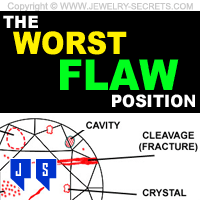
Inclusions and flaws in a diamond are one of the things that make a diamond unique.
Every dot, every line, every cloud is one of a kind.
Some flaws are good (identification), some are bad (visible and vulnerable), and some flaws are in the worst possible position ever…
Before we get into this, let’s get into flaws…
What is a flaw?
A flaw is an intrusion or imperfection with in a diamond.
A diamond is made up of 100% pure carbon and was created billions of years ago by heat and pressure in the Earth’s crust. If all diamonds remained and hardened as pure carbon, all diamonds would be flawless.
But nature doesn’t work that way. In the molten flowing liquids, other particles like irons, minerals and gases mix with the carbon during creation and trapped the inclusions in the stone forever.
Some stones ended up getting filled with tons of debris. Others came out pretty clean. Flaws are labeled many things like:
- Feathers
- Cleavages
- Fractures
- Bearded Girdle
- Cavities
- Bruise
- Chips
- Grain Lines
- Clouds
- Laser Drill Holes
- Pinpoints
See the image below of flaws and inclusions in a diamond…
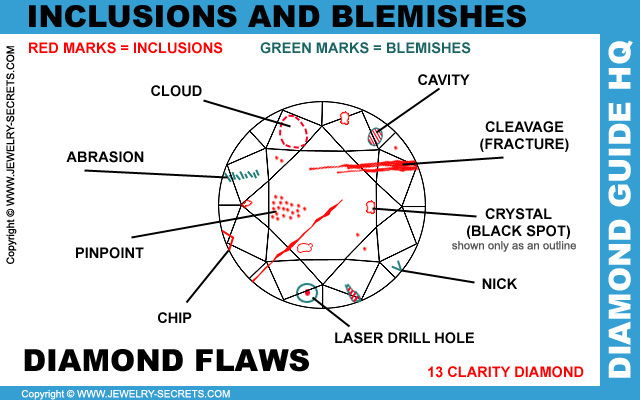
Flaws can be internal (inside the stone) called inclusions; or they can be external (on the stone’s surface) called blemishes.
Blemishes are things like:
- Knots
- Extra Facets
- Abrasions
- Naturals
- Nicks
- Polish Lines
- Pits
- Polish Marks
- Rough Girdles
- Scratches
- Grain Lines
Both types of flaws can affect the clarity of a diamond.
Flaws affect clarity:
Clarity is a very opinionated subject. No two diamonds are identical so each and every stone has to be evaluated and graded on an individual basis. All flaws and inclusions have to be scrutinized under 10x powered magnification (like a microscope or a 10x jeweler’s loupe). And, more often than not, 3 or more experts have to evaluate the diamond to arrive at a single conclusion.
Not only does the size and amount of the flaws affect clarity, but the color and position as well.
Generally, flaws that fall towards the center of the stone get a lower clarity rating.
Compare a VS1 diamond to a VS2 diamond below…
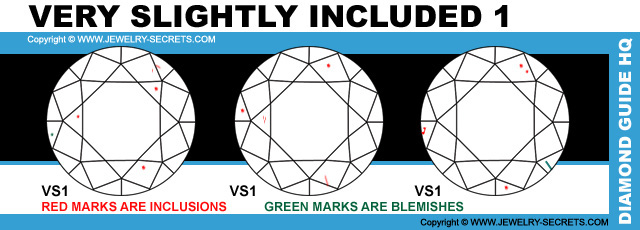
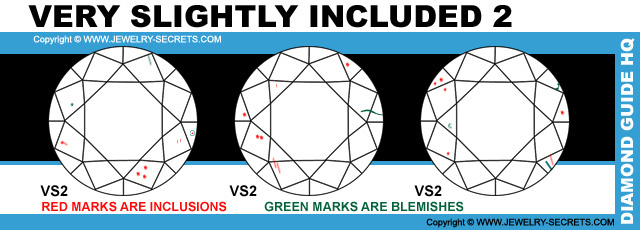
You’ll see that flaws in VS diamond usually stay under the upper crown facets (not in the center of the stone). The flaws in the VS2 diamond are bigger and more abundant (ever so slightly).
SI1 diamonds and SI2 are the same way, but the flaws get more pronounced and as you can see, much bigger.
Compare the two stones below. In the SI2, the flaws get even bigger and fall towards the center of the diamond underneath the table.
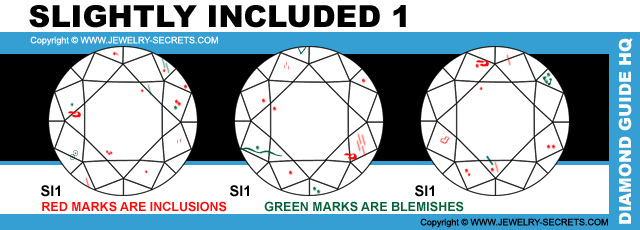
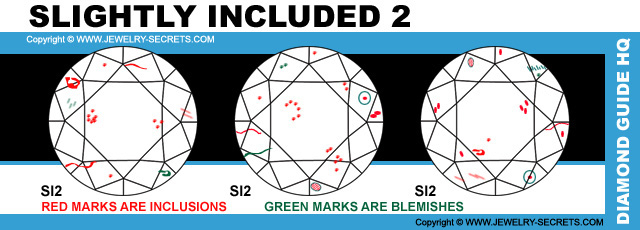
Check out more diamonds here:
| CARAT, CLARITY, COLOR, CUT, POL, SYM, FLUOR | PRICE | VIEW |
| 1.00, VS1, E, EX, EX, EX, NONE | $6,500 | VIEW |
| 1.00, VS2, E, EX, EX, EX, NONE | $5,500 | VIEW |
| 1.00, SI1, E, EX, EX, EX, NONE | $3,500 | VIEW |
| 1.00, SI2, E, EX, EX, EX, NONE | $2,300 | VIEW |
(Prices shown above are for excellent diamonds, with pure white color, some of the best diamonds you can buy; good at the time of this post.)
Sometimes it’s the size of the flaw that brings down the grade. Other times it’s the amount or position. Grading diamonds really is a complicated and opinionated matter and everything has to be taken into consideration. What makes one stone an SI1 could make another stone and SI2 depending on the other flaws in the stone and even the carat weight of the stone. Most of these differences are so minute that to an untrained eye, they become almost impossible to detect.
That’s why most people don’t notice clarity until it slaps them in the face.
What slaps them?
The eye-visible inclusions.
Visible inclusions:
Most people really do judge the quality of a diamond all based upon the fact that they can either see the inclusions with the bare eye, or they can’t.
If they can’t see the flaws, then they consider that diamond a good diamond quality.
I can understand this logic because, quite frankly, no one really wants to see huge black spots in their beautiful diamond engagement ring. Would you?
Black spots take away from the beauty of a diamond. When flaws are obvious, that’s all we see.
And what clarity grade are they the most obvious?
I clarity diamonds:
I clarity means included diamonds. See picture below…
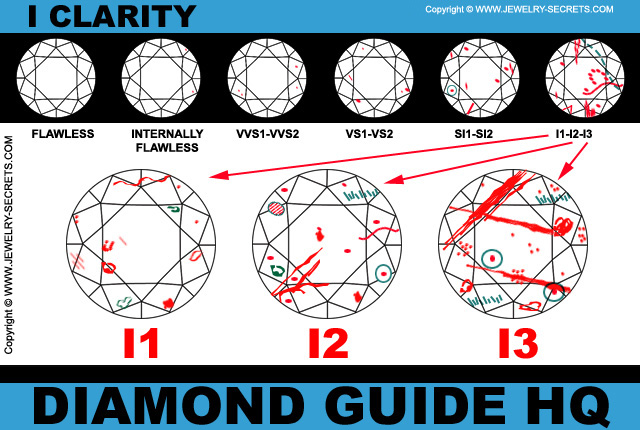
I clarity means that the diamond has such huge flaws in it that you can literally see them without a microscope, or 10x magnification (like a jeweler’s loupe).
| CARAT, CLARITY, COLOR, CUT, POL, SYM, FLUOR | PRICE | VIEW |
| 1.00, I1, E, EX, EX, EX, NONE | $2,100 | VIEW |
You can see these flaws just by looking at the diamond. And the further down you go in clarity (I2 or I3) the worse the flaws become.
So it’s safe to say that if you buy a diamond with a clarity grade of I1, I2 or I3, you may not be happy with what you see.
Some diamonds are so full of inclusions they block the light and lack most brilliance and sparkle.
Some diamonds get so bad and milky, they look like an ugly piece of salt. Not a pretty sight.
Carat weight matters:
Keep in mind that the size of the diamond makes a difference too. It’s harder to see inclusions in a smaller diamond. In stones like .25 carat (25 points, 1/4 ct) you may not see the flaws at all no matter what the quality is. But when you get into much bigger carat weights like .50 ct, .75 ct or 1.00 carat and up, flaws can make a huge impact on how a diamond looks. And trust me, position is everything.
The worst possible flaw position:
What is the worst spot for a flaw?
Dead center!
The center of the stone (directly underneath the table of the diamond) is the worst area for any inclusion to reside.
The table is the top flat portion of the diamond and any flaw that sits directly below it becomes pretty visible to the viewer. Especially if it’s a black carbon spot. The table doesn’t have angled facets on it that help hide flaws like the facets around the table (which is the crown, the best position for a flaw to hide). See image below…
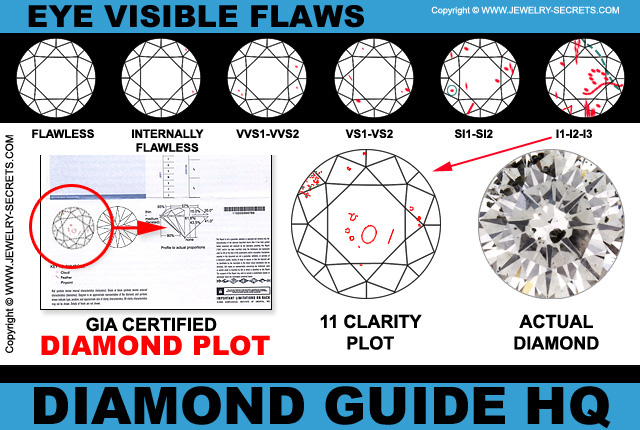
The diamond shown above is an I1 clarity, F color, 1.00 selling for $1,700.
You can see flaws and imperfections in a diamond plot if you purchase a certified stone (I recommend GIA’s full diamond report). You can compare the flaws on the plot to what you see under a microscope. It gets pretty fascinating.
But, even though the center of the stone is the worst for seeing visible inclusions, there is one worse position for a flaw to be in…
Flaws on the girdle
The girdle is the outside rim that runs around the entire stone. It divides the top portion of the diamond (the crown), from the bottom part of the diamond (the pavilion). This girdle can be of different thicknesses, from none to extremely thick (as noted on a diamond certificate). If the girdle gets too thin (as in none or extremely thin), it becomes weak, brittle and can chip easily.
Flaws can do the same thing.
Flaws on or around the girdle can make a diamond vulnerable. Cracks, nicks, chips and fractures can affect the structure, integrity and durability of the stone. I clarity stones are weak, but I3 clarity stones are weak all over. See image below…
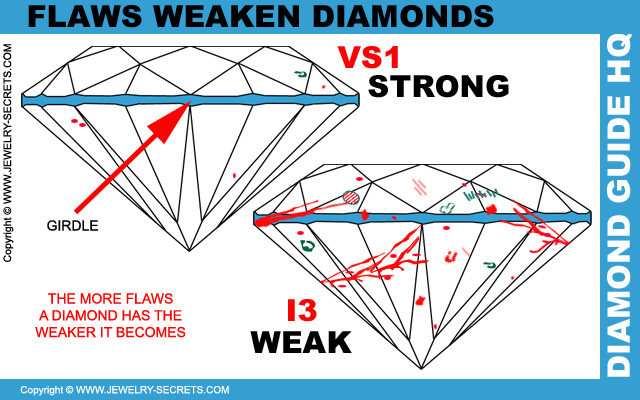
A good hit or strike could make these chips or cracks bigger. Sometimes they can bust the diamond wide open and actually break the stone in half.
So while eye visible flaws straight down in your stone can really diminish its beauty, a flaw on the side of the stone could destroy it.
This is why you must do one thing before you purchase any diamond…
Microscope the stone.
Look at the diamond under 10x magnification (buy yourself an microscope or a 10x jeweler’s loupe). Check out the flaws. Look for chips or nicks around the girdle or upper facets. Check the stone from all angles, top, side and bottom (especially if it’s an I clarity stone).
I clarity is I clarity for a reason. If you want to get away from flaws that you can see with the eye, you’ll have to move on up into higher diamond clarities.
I recommend SI1 or higher (SI2 is alright, but it’s also a highly questionable stone. You can still see flaws in an SI2 stone from the side view – you shouldn’t be able to see them from the top down view).
So the worst position for flaws are:
- Straight down under the table because they’re visible.
- Around the outside of the stone where they become vulnerable
Compare an I clarity diamond to an SI clarity and VS clarity diamond below…
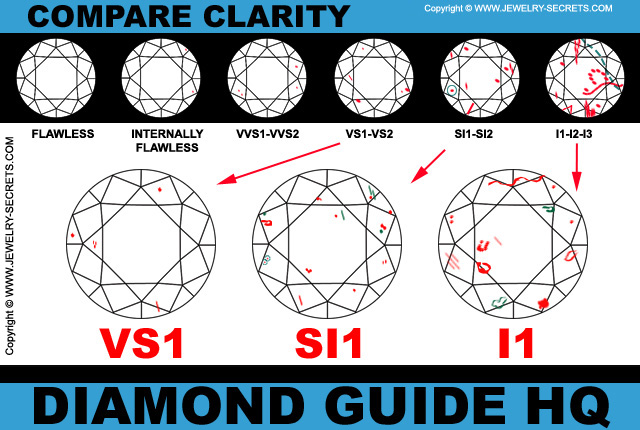
There’s a huge difference under the scope.
I clarity diamonds are cheaper, but like everything in life, there is a sacrifice to pay in quality, durability and beauty.
It all comes down to you and what you’re willing to live with.
So tell me, what position are your flaws in?
Check out more recommended diamonds here at James Allen.
Cheers! :)














Leave a comment